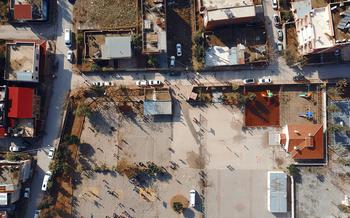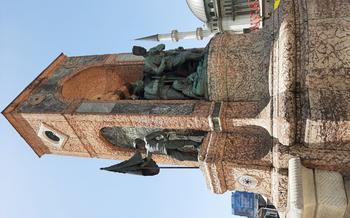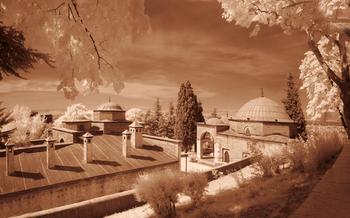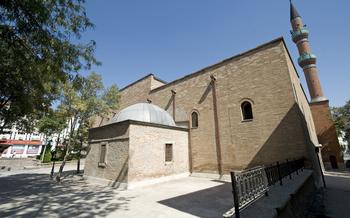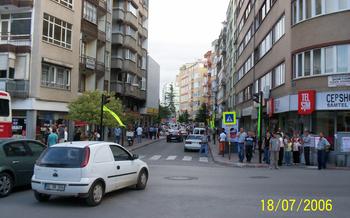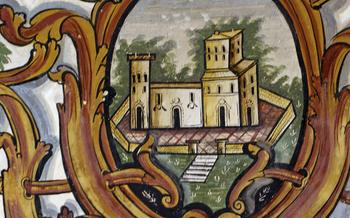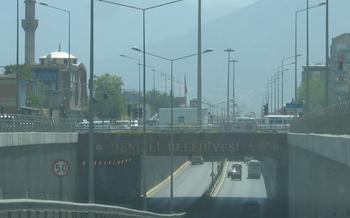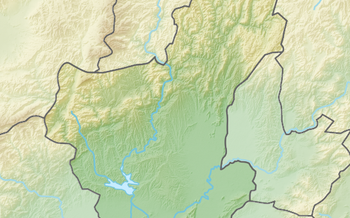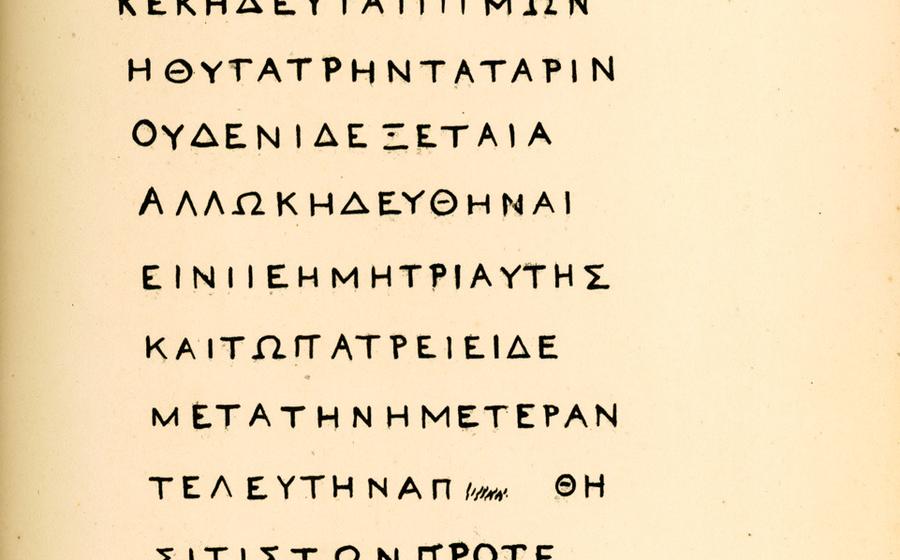
Kaleiçi Mosque
- Historical Significance
- Architectural Beauty
- Religious Significance
- Cultural Symbol
- Local Traditions
- Visiting Hours and Etiquette
- Guided Tours
- Photography and Videography
- Accessibility for Visitors
- Nearby Attractions
- Local Cuisine
- Souvenir Shopping
- Transportation Options:
- Language and Communication
- Insider Tip: Unveiling the Enchanting Evening Splendor
Historical Significance
Built in the 18th century, the Kaleiçi Mosque stands as a testament to Denizli's rich history and architectural heritage. Its construction showcases a harmonious blend of Ottoman and Seljuk influences, reflecting the diverse cultural currents that have shaped the city over the centuries. As a cultural and religious landmark, the mosque holds immense significance for the local community, serving as a central place of worship and a symbol of faith. Over the years, the mosque has undergone several restoration efforts, preserving its grandeur and ensuring its continued prominence as a cherished historical monument.
Architectural Beauty
As you approach the Kaleiçi Mosque, its striking architectural features will captivate your attention. The exterior of the mosque is adorned with intricate stone carvings, showcasing the skill and artistry of Ottoman and Seljuk craftsmen. Admire the delicate floral motifs, geometric patterns, and elegant calligraphy that embellish the walls and arches.
Step inside the mosque to marvel at its spacious prayer hall, supported by rows of graceful columns. The mihrab, a niche indicating the direction of prayer, is a masterpiece of craftsmanship, adorned with colorful tiles and intricate carvings. The high ceiling is adorned with elaborate chandeliers, casting a warm glow over the interior.
Notice the harmonious blend of traditional Islamic architecture with local influences. The mosque's design incorporates elements of Seljuk architecture, evident in the pointed arches and ribbed domes. At the same time, it showcases Ottoman influences, such as the use of colorful tiles and intricate stonework.
The Kaleiçi Mosque stands out from other mosques in the region due to its unique features. Its spacious courtyard, surrounded by arched colonnades, provides a serene space for contemplation and relaxation. The minaret, with its slender shaft and elegant balcony, offers breathtaking views of Denizli and the surrounding countryside.
Take your time to explore the mosque's architectural details and appreciate the blend of artistic traditions that have shaped its appearance. The Kaleiçi Mosque is a testament to the rich cultural heritage of Denizli and a must-visit for anyone interested in Islamic architecture and history.
Religious Significance
As a significant religious landmark, the Kaleiçi Mosque serves as a place of worship for the Muslim community in Denizli. It holds daily prayers, including the five obligatory prayers (Fajr, Dhuhr, Asr, Maghrib, and Isha), where worshippers gather to offer their devotion and seek spiritual guidance. The mosque also hosts special religious ceremonies and events throughout the year. During the holy month of Ramadan, the mosque becomes a place of intense devotion and spiritual reflection, with special prayers, Taraweeh, and Quran recitations taking place during the evenings. The mosque plays a vital role in fostering a sense of community among Muslims, serving as a gathering place for various religious and social activities. It is a place where people come together to celebrate Islamic festivals, share joys and sorrows, and reinforce their faith and connection to the divine. The Kaleiçi Mosque stands as a testament to the deep religious traditions and values that are deeply ingrained in the culture and identity of Denizli.
Cultural Symbol
As a significant cultural symbol, the Kaleiçi Mosque holds a prominent place in the hearts of Denizli's citizens. It stands as a testament to the city's rich history, architectural heritage, and religious traditions. The mosque has played a pivotal role in shaping Denizli's identity and sense of place, serving as a gathering point for the community and a symbol of unity. Various cultural events and activities are held at the mosque, fostering a sense of belonging and cultural exchange. Its unique architectural features and spiritual significance have made it an iconic landmark, attracting visitors from around the world. The Kaleiçi Mosque embodies the essence of Denizli's cultural heritage and continues to be a source of pride and inspiration for its people.
Local Traditions
As you step into the Kaleiçi Mosque, it's important to be mindful of the local customs and traditions associated with this sacred space. Dress modestly and respectfully, covering your shoulders and knees. When entering the mosque, remove your shoes and place them neatly on the designated shelves. Inside the prayer hall, maintain a quiet and reverent demeanor, avoiding loud conversations or disruptive behavior. Observe the worshippers around you and follow their lead in terms of prayer rituals and etiquette. If you're unsure about any customs, feel free to ask a local guide or another visitor for guidance. By respecting the local traditions and customs, you'll not only show your appreciation for the mosque but also contribute to creating a harmonious and respectful environment for all visitors.
Visiting Hours and Etiquette
Visiting Hours: The Kaleiçi Mosque welcomes visitors during specific hours to ensure that religious activities are not disrupted. Generally, the mosque is open to non-Muslim visitors outside of prayer times. It is advisable to check the official website or with local tourism authorities for the most up-to-date information on visiting hours.
Dress Code and Behavior: When visiting the Kaleiçi Mosque as a non-Muslim, it is essential to adhere to the local customs and dress code. Visitors should dress modestly and respectfully, covering their shoulders and knees. Women may also be required to cover their heads with a scarf or headscarf. It is important to maintain a respectful and quiet demeanor within the mosque, avoiding loud conversations or disruptive behavior.
Prayer Hall Access: Non-Muslims are generally not permitted to enter the prayer hall during prayer times. However, visitors may be allowed to enter the prayer hall outside of these times with permission from the mosque authorities. It is important to be respectful and understanding of the religious practices and traditions of the Muslim community.
Best Time to Visit: To avoid crowds and ensure a peaceful experience, it is recommended to visit the Kaleiçi Mosque outside of prayer times and during weekdays. This will allow you to explore the mosque's interior and admire its architectural details without distractions.
Guided Tours
Enhance your visit to the Kaleiçi Mosque by booking a guided tour and gaining deeper insights into its history, architecture, and religious significance. Opt for a group tour to meet fellow travelers and share experiences, or choose a private tour for a more personalized and immersive experience. Knowledgeable guides will provide detailed explanations, answer your questions, and help you appreciate the mosque's unique features. Guided tours typically cover the mosque's construction, architectural elements, religious practices, and cultural significance. They also offer anecdotes and stories that bring the mosque's history to life. Consider the cost and availability of guided tours when planning your visit. Booking in advance is recommended to secure a spot, especially during peak tourist seasons.
Photography and Videography
Respecting the Sanctity of the Mosque
When visiting the Kaleiçi Mosque, it is essential to be mindful of the regulations regarding photography and videography. While capturing the beauty of the mosque through your lens is understandable, it is crucial to respect the privacy of worshippers and avoid disruptive behavior.
Designated Areas for Photography
Photography is permitted in certain designated areas within the mosque. These areas are typically marked or indicated by signs. It is important to adhere to these guidelines and refrain from taking photographs in restricted sections, such as the prayer hall during prayer times.
Avoiding Disruption and Flash Photography
When taking photographs, be mindful of your surroundings and avoid using flash photography, as it can be distracting and disruptive to worshippers. Instead, use natural light or low-light settings to capture the mosque's beauty without disturbing the religious activities.
Alternative Ways to Capture the Mosque's Beauty
If photography is not permitted in certain areas, consider alternative ways to capture the essence of the mosque. Sketching or painting can be a wonderful way to express your artistic interpretation of the mosque's architecture and intricate details. Additionally, simply observing and appreciating the mosque's beauty without the need for photography can be a deeply enriching experience.
By following these guidelines and demonstrating respect for the sanctity of the mosque, visitors can contribute to preserving its serene atmosphere while still capturing its architectural splendor through photography and videography.
Accessibility for Visitors
The Kaleiçi Mosque is committed to providing a welcoming and accessible environment for visitors with disabilities or special needs. The mosque features a number of accessibility features to ensure that everyone can enjoy their visit.
Wheelchair users and visitors with mobility impairments will find ramps and elevators that provide easy access to all areas of the mosque. Designated seating areas are also available within the prayer hall for those who need additional support.
The mosque staff is always happy to assist visitors with disabilities or special needs. They can provide information about the mosque's accessibility features and offer assistance with any aspect of the visit.
To ensure a comfortable and enjoyable experience, it is recommended that visitors with disabilities or special needs contact the mosque in advance to inform them of their requirements. This will allow the mosque staff to make any necessary arrangements to accommodate their needs.
By providing these accessibility features and support services, the Kaleiçi Mosque ensures that everyone can experience the beauty and serenity of this historic and sacred site.
Nearby Attractions
Enrich your visit to the Kaleiçi Mosque by exploring the captivating historical and cultural attractions that lie in its vicinity. Just a short stroll away, discover the imposing Denizli Castle, a testament to the city's rich past. Explore its ancient ramparts, marvel at its intricate architecture, and immerse yourself in the tales of its former glory.
Delve into the depths of history at the Denizli Archeological Museum, where a treasure trove of artifacts awaits. Discover ancient relics, stunning mosaics, and intriguing inscriptions that shed light on the region's fascinating past. Embark on a journey through time as you uncover the secrets of civilizations long gone.
Indulge in the vibrant atmosphere of the Grand Bazaar, a bustling marketplace where colors, sounds, and scents intertwine. Experience the thrill of haggling for unique souvenirs, from handwoven carpets to exquisite jewelry. Immerse yourself in the local culture as you navigate the labyrinthine streets and discover hidden gems that reflect the city's rich heritage.
Local Cuisine
Indulge in the tantalizing flavors of Denizli's local cuisine, renowned for its succulent kebabs, freshly baked pide, and gözleme, a savory flatbread stuffed with various fillings. Embark on a culinary adventure near the Kaleiçi Mosque, where you'll find an array of restaurants and eateries catering to every palate. Discover the art of Turkish barbecue at traditional kebab houses, where skewers of marinated meats are grilled to perfection over glowing coals. Savor the crispy crust and tender interior of pide, topped with an assortment of flavorful ingredients. Don't miss the gözleme, a versatile flatbread that can be filled with cheese, spinach, potatoes, or minced meat. Experience the vibrant food culture of Denizli as you savor the authentic flavors of these local delicacies.
Souvenir Shopping
As you stroll through the vibrant streets near the Kaleiçi Mosque, take the opportunity to explore the charming souvenir shops and bazaars that line the way. These hidden gems offer a treasure trove of unique gifts, handmade crafts, and traditional textiles that capture the essence of Denizli's rich cultural heritage.
Discover intricate carpets adorned with vibrant motifs, hand-painted ceramics showcasing stunning patterns, and exquisite jewelry crafted with meticulous care. Browse through an array of local delicacies, including mouthwatering Turkish delights, aromatic spices, and delectable dried fruits.
Engage in the lively bargaining culture and hone your negotiation skills to secure the best deals. Support the local economy and take home a piece of Denizli's charm by purchasing souvenirs from the friendly vendors. Whether you seek a meaningful memento for yourself or a thoughtful gift for loved ones, the souvenir shops near the Kaleiçi Mosque promise an unforgettable shopping experience.
Transportation Options:
Reaching the Kaleiçi Mosque is a breeze, thanks to the diverse transportation options available. Public transportation enthusiasts can hop on a bus or minibus that conveniently drops them off near the mosque's doorstep. For those who prefer a more personalized journey, taxis are readily available and offer a direct route to the mosque. However, if you seek the freedom to explore Denizli at your own pace, renting a car is an excellent choice. With a rental car, you can conveniently navigate the city's streets and venture beyond the mosque to discover other hidden gems. Explore the various transportation options, consider their cost-effectiveness and convenience, and choose the one that best suits your travel style and budget.
Language and Communication
Denizli's official language is Turkish. While English is understood and spoken by many locals in the tourism industry, it's not as widely prevalent as in major cities like Istanbul or Antalya. To enhance your communication with locals and navigate the city smoothly, consider learning a few basic Turkish phrases and gestures. This will show respect for the local culture and help you connect with the friendly people of Denizli.
If you're concerned about language barriers, you can hire a translator or guide to accompany you during your visit to the Kaleiçi Mosque. They can provide valuable insights into the mosque's history, significance, and cultural customs, ensuring a more enriching experience. Embrace the cultural differences and be open to new experiences, as part of the charm of traveling to a foreign country lies in discovering and understanding its unique customs and traditions.
Insider Tip: Unveiling the Enchanting Evening Splendor
As the sun sets and the sky transforms into a canvas of vibrant hues, the Kaleiçi Mosque takes on a new persona, exuding an enchanting aura that captivates the senses. Bathed in the warm glow of artificial lights, the mosque's intricate stone carvings and decorative elements come alive, casting mesmerizing shadows that dance upon its facade. This ethereal ambiance creates a sense of serenity and tranquility, inviting visitors to immerse themselves in the mosque's spiritual essence.
Stroll through the mosque's courtyard and marvel at the breathtaking views of the illuminated minarets reaching towards the heavens. Capture stunning photographs of the mosque against the backdrop of the night sky, where stars twinkle like celestial diamonds. Experience the unique charm of the mosque after the daytime crowds have dispersed, allowing you to connect with its sacredness on a deeper level.
Whether you're a history buff, an architecture enthusiast, or simply seeking a tranquil retreat, visiting the Kaleiçi Mosque during the evening is an experience not to be missed. Embrace the mosque's enchanting allure and discover its hidden treasures under the cloak of darkness.
